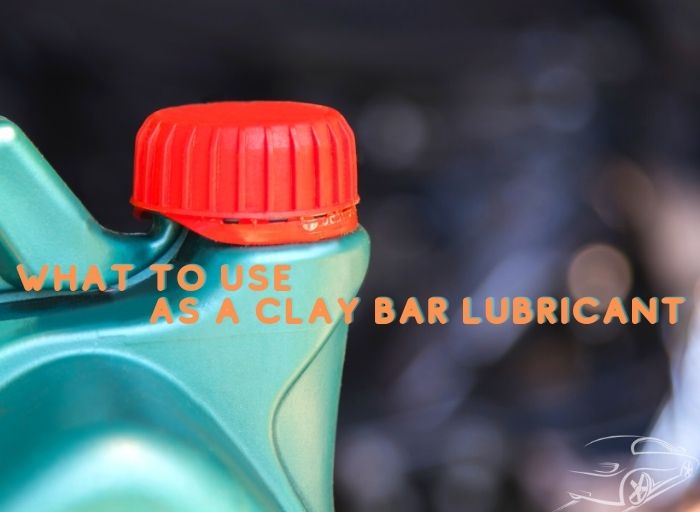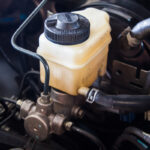
You love your vehicle, and so you take good care of it by washing and waxing it regularly. You want to do the same for your car, but you’re not quite sure what to use as a clay bar lubricant? Don’t worry. I have everything you need in this article from why we should use clay bar lube to some alternative options.
Table of Contents
What is Clay Bar Lubricant?
A clay bar or clay block is a tool used to smooth out paint by rubbing it against the surface of the vehicle. A clay bar is a very fine-grained “clay” that is rubbed on the surface.
Lubricant is applied to a vehicle’s surface, and the clay bar is run over it in order to remove small imperfections such as water spots, bird droppings, paint overspray, etc. The clay bar does not remove scratches; rather it polishes the paint to restore its gloss, thereby removing blemishes.
Do you think: Does WD40 cause car paint scratches?!
Clay Bar Lubricant Pros & Cons
Pros of Clay Bar Lubricant
You want to protect your vehicle’s paint when you use a clay bar. By applying this lube, you can limit paint damage such as scratches and swirls. Depending on your price range, different types of lubes are on the clay bars market. Some of them may have chemicals in them which could be harmful to your paint.
Cons of Clay Bar Lubricant
Clay Bar Lubricant is only a lubricating agent and not a paint sealant. It cannot replace the need to use a clay bar with a proper paint product.
Why Is Clay Bar Lubricant Necessary?
For a real detailing process, clay bar lubricant is necessary for several reasons when using a clay bar during the process of automotive detailing. Here’s why:
Preventing Clay Bar Sticking
First and for most, without lubrication, clay bars tend to stick to the paint, making it difficult to move them across the surface. The lubricant ensures the clay bar can glide effortlessly, preventing it from adhering to the paint and potentially causing damage.
Reducing Friction
Clay bars are designed to remove contaminants and debris from the surface of a vehicle’s paint. However, using a clay bar directly on the paint without lubrication can create friction, which may cause marring or scratching. Clay bar lubricant acts as a lubricating agent that minimizes friction and allows the clay bar to glide smoothly over the surface.
Enhancing Effectiveness
The lubricant helps the clay bar effectively lift and encapsulate contaminants from the paint. It provides a slippery barrier between the clay bar and the surface, allowing the clay to grip and pull out embedded dirt, industrial fallout, brake dust, and other contaminants without scratching the paint.
Spreading and Dilution
Clay bar lubricants are usually formulated to have a high lubricity, meaning they are specifically designed to provide a smooth, slick surface. This allows the lubricant to spread easily and evenly over the paint, ensuring uniform lubrication. Additionally, some lubricants can be diluted with water, making them more cost-effective and easier to use.
Protection and Cleaning
Many clay bar lubricants contain additional protective and cleaning agents. They may offer a mild cleaning action, removing light dirt and grime from the surface. Some lubricants also have ingredients that provide a layer of temporary protection, such as polymers or waxes, which can enhance the shine and gloss of the paint.
What to Use as a Clay Bar Lubricant
If you want to see how much clay lube is on Amazon, click this link.

Clay Bar Lubricant Types
- Quick detailer sprays
- Water-based clay bar lubricants
- Dedicated clay bar lubricant gels
There are many different types of clay bar lubricants available. When you purchase the lubricant that works best for your vehicle, remember to check the label carefully so you’ll know just what it is doing for your paint and which one you should use on your vehicle.
Check out: Mothers 07240 California Gold Clay Bar System Review
Quick Detailer Sprays
Quick detailer sprays are spray-on products typically used for quickly enhancing the appearance of a vehicle’s paint. They are designed to provide lubrication when using a clay bar but offer additional benefits such as cleaning, shine enhancement, and light protection. Quick detailer sprays are convenient and widely available in automotive stores.
Pros:
- Widely available and easy to find.
- Often provide additional cleaning and gloss-enhancing properties.
- Can be used as a lubricant during the clay bar process as well as a quick touch-up spray for maintenance.
Cons:
- May have lower lubricity compared to dedicated clay bar lubricants, requiring more frequent reapplication.
- Some quick detailer sprays may contain fillers or silicones that can interfere with subsequent paint protection products.
Water-based Clay Bar Lubricants
Water-based clay bar lubricants are formulated using a water base instead of solvent or oil. These lubricants are typically eco-friendly and safe to use on various surfaces. They offer lubrication during the clay bar process to reduce friction and prevent scratching, while being easy to rinse off without leaving residue behind. Water-based clay bar lubricants are often preferred for their safety and compatibility with other detailing products.
Pros:
- Environmentally friendly and safe to use on all surfaces.
- Typically offer good lubrication for effective clay bar usage.
- Easy to rinse off without leaving residue.
Cons:
- May not provide as much gloss enhancement or cleaning power as other lubricant types.
- Could freeze or become less effective in cold temperatures.

Dedicated Clay Bar Lubricant Gels
Dedicated clay bar lubricant gels are specifically formulated to provide optimal lubricity for clay bar usage. They are designed to have a gel-like consistency, allowing them to cling to the surface and provide extended lubrication. These lubricants offer superior cleaning power and may contain additional ingredients for enhanced surface protection. Professional detailers often favor dedicated clay bar lubricant gels for their high-performance characteristics.
Pros:
- Specifically formulated with high lubricity for optimal clay bar performance.
- Often designed to cling to the surface, reducing the need for frequent reapplication.
- Can provide superior cleaning power and surface protection.
Cons:
- Generally more expensive than quick detailer sprays or water-based alternatives.
- May require additional rinsing or wiping to remove any residue after clay bar usage
What Is the Best Clay Bar Lubricant?
Best clay bar lubricants have the below qualities that push the clay bar treatment to its peak.
The best clay bar lubricant should be compatible with different clay bars
When choosing a clay bar lubricant, it’s essential to consider its compatibility with different types of clay bars. Some lubricants may work better with specific clay bars due to variations in their formulations. It’s important to ensure that the lubricant you choose is suitable for the clay bar you intend to use. This information can usually be found on the product label or in the manufacturer’s instructions.
Lubrication effectiveness
The primary purpose of a clay bar lubricant is to provide effective lubrication during the clay bar process. It should have sufficient lubricity to allow the clay bar to glide smoothly over the surface without causing friction, marring, or scratching.
Look for lubricants specifically designed for clay bar usage with high lubrication effectiveness. User reviews and recommendations from professional detailers can help you assess the lubrication performance of different products.
Safety for the vehicle’s paint
The paint on your vehicle is delicate and can be easily damaged if proper care is not taken. Therefore, selecting a clay bar lubricant that is safe for the vehicle’s paint is crucial.
Look for lubricants that are specifically formulated to be gentle and non-abrasive. Avoid products that contain harsh chemicals or abrasive ingredients that can potentially harm the paint finish.
Water-based lubricants and dedicated clay bar lubricant gels are considered safe options for the vehicle’s paint.
Check out: How to use clay bars on glass safely in car detailing!
Clay Bar Lubricant Alternatives

If you run out of clay bar lubricant and you need something quick to complete your detailing task. I have here some fantastic homemade clay bar lubricants that you can use in a pinch:
#1 Water and Car Wash Soap Mixture
- Car soap
- Spray bottle
How to make it:
Mix water and a small amount of car wash soap in a spray bottle. The ratio can be around 16 parts water to 1 part car wash soap.
Pros:
- Easy to make with common household ingredients.
- Car wash soap provides some lubricity for clay bar usage.
- Can be effective in removing light dirt and grime.
Cons:
- May not offer the same level of lubrication as dedicated clay bar lubricants.
- Not ideal for heavily contaminated surfaces or stubborn contaminants.
#2 Diluted Shampoo Solution as Clay Bar Lubricant
- pH-neutral shampoo
- Spray bottle
How to make it:
Dilute a mild automotive or pH-neutral shampoo with water in a spray bottle. The specific dilution ratio can vary depending on the shampoo, but generally, a ratio of 10 parts water to 1 part shampoo works well.
Pros:
- Shampoos are designed to be gentle on paint and can provide sufficient lubrication.
- Can help in removing light dirt and grime.
- Some shampoos have additional cleaning and gloss-enhancing properties.
Cons:
- Shampoos may leave a residue if not properly rinsed off.
- Not as effective on heavily contaminated surfaces or stubborn contaminants.
#3 Isopropyl Alcohol and Water Mixture
- Isopropyl alcohol or rubbing alcohol
- Spray bottle
How to make it:
Mix isopropyl alcohol (rubbing alcohol) and water in a spray bottle. A common ratio is 1 part isopropyl alcohol to 3 parts water.
Pros:
- Isopropyl alcohol helps dissolve certain contaminants and provides lubrication.
- Can effectively remove some types of residue, such as wax or sealant build-up.
- Dries quickly and leaves a clean surface.
Cons:
- Isopropyl alcohol can dry on certain materials, so it’s important to perform a spot test on the surface before using it.
Not suitable for all paint types or sensitive surfaces.
It’s important to note that homemade clay bar lubricants may not match the performance of commercial products specifically formulated for the task. They are generally more suitable for light to moderate contamination and maintenance clay bar treatments.
You can check out this video for how to make clay lub with ONR!
Clay Bar Lubricant and Clay Bar Technique
If you’re used to hand-application polishing, you must wonder what a clay bar is and what it does for your vehicle’s paint. With this tool and its lubricant, the process of polishing is done more efficiently.
The clay bar replaces the hand application of the polish. You can effectively remove polishing oils from the paint’s surface with the clay bar. This allows for a much more professional finish and will leave the paint with a nice shine instead of a dull look like it would have if you were to polish it by hand.
Find out: How to make your car shining just like glass?!
How to Use Clay Bar Lubricant
There are two types of clay bars to choose from: soft and hard clay bars. The soft clay bar is more flexible and is easy for you to apply. Most people like this bar type because they find the hard clay bar harder to handle.
Use a soft clay bar if you have larger vehicles that need regular maintenance or can do the job yourself. If you don’t have the means to apply it, go with the hard clay bar instead.
Using clay bar lubricant properly is crucial for achieving optimal results and avoiding damage to the vehicle’s paint. Here’s a step-by-step guide on how to use clay bar lubricant:
- Wash the vehicle: Start by washing the vehicle thoroughly with a pH-neutral car wash soap and rinsing it clean. This step helps remove loose dirt and debris from the surface before using the clay bar.
- Preparation: Ensure that both the clay bar and the surface you’ll be working on are cool to the touch. Working on small sections at a time (e.g., a panel or half a panel) is recommended to maintain control and prevent the lubricant from drying out.
- Apply clay bar lubricant: Shake the clay bar lubricant bottle well before use. Spray a generous amount of lubricant onto the section you’ll be working on. The lubricant should provide a slick surface for the clay bar to glide on.
- Work the clay bar: Take a small piece of the clay bar and flatten it in your hand to create a palm-sized, manageable piece. Press the clay bar gently against the lubricated surface and begin moving it back and forth with light to moderate pressure.
- Maintain lubrication: As you glide the clay bar across the surface, periodically check the lubrication. If the lubricant starts to dry out or diminish, spray more lubricant onto the section. The surface should remain well-lubricated throughout the process to prevent scratching.
- Check the clay bar: As you work, occasionally inspect the clay bar for contamination. If you notice significant buildup or discoloration on the clay bar, fold or knead it to expose a fresh, clean surface. This helps ensure the effective removal of contaminants and prevents potential scratching.
- Work in small sections: Continue working in small sections, systematically moving across the vehicle. Avoid excessive pressure or aggressive movements to minimize the risk of marring or scratching the paint.
- Wipe off residue: Once you’ve completed each section, use a clean microfiber towel to wipe off any remaining lubricant residue. Inspect the surface for smoothness and cleanliness. Repeat the process on the next section until the entire vehicle has been clayed.
- Final wash and protection: After clay bar treatment, washing the vehicle once again is recommended to remove any remaining residue. You can then apply wax, sealant, or other protective products to enhance and preserve the vehicle’s finish.
Helpful Tips for Using Clay Bar Lubricants
Some detail can make a big difference. Here are some useful tips for using clay bar lubricants that you might not notice:
- Use sufficient lubricant: Apply a generous amount of clay bar lubricant to your working surface. The lubricant should create a slick and slippery surface to ensure the smooth gliding of the clay bar. If the lubricant starts to dry or diminish, reapply it to maintain proper lubrication.
- Start with light pressure: Begin using the clay bar with light pressure and gradually increase it as needed. Excessive pressure can increase the risk of marring or scratching the paint. Allow the clay bar to work by gently gliding over the lubricated surface.
- Use proper technique: Move the clay bar back and forth or side to side in straight lines. Avoid circular motions, as they can create swirl marks. Keep the clay bar parallel to the surface and maintain a smooth, even motion. Be mindful of any raised emblems, moldings, or sharp edges to avoid catching the clay bar.
- Avoid working on hot surfaces: Clay bar treatment is best performed on cool surfaces. Working on a hot surface can cause the lubricant to evaporate quickly, making it difficult to glide the clay bar smoothly. If necessary, park the vehicle in a shaded area or work during cooler parts of the day.
Check out this video for how to clay bar your car!
FAQs
#1 Can I Use Water as Clay Lube?
Water alone is not recommended as a clay bar lubricant. While it may provide some lubrication, it lacks the necessary viscosity and lubricity to minimize friction effectively. Using water as a lubricant increases the risk of marring or scratching the paint surface.
A wet clay block is the only way to make water work as a clay bar lubricant. In other words, you need to have the lubricant on the clay bar itself. This might not be what you wanted to hear, but clay bars are indeed used with oils and waxes.
#2 What is the Best Clay Bar Lubricant?
There are many types available to you. You can choose the one that works best for your paint. If you have an SUV, you may want a non-abrasive clay bar lubricant. If your vehicle is smaller, then a clay bar lubricant with substances called silicones might be the best choice for you. Be sure to read the label directions carefully and follow what it says in order to get the best result.
Related: Can You Clay Bar Ceramic Coating?
#3 Can You Make Your Own Clay Lubricant?
Not really. You can try it, but you will find that it isn’t as effective as a store-bought clay bar lubricant. You should continue to buy your clay bar lubricant because it is the best way to get the job done right and ensure your vehicle’s paint looks its best after each wash or polish.
#4 How Much Clay Lube Do You Need?
You can use as little as a shot glass worth or go all out and use a quart for larger vehicles. A shot glass is enough for most cars, but if you’re on a budget, then a quart will get the job done without breaking the bank.
#5 How Long Would You Need To Spend With The Clay Bar Lubricant?
The clay bar lubricant will give you results in approximately 30 minutes after its application. This is when you should take a break and give your hands some rest. To get the best results, spend about 30 minutes with the clay bar lubricant before you wipe it off.
#6 What Happens if I Use a Clay Bar without Lubricant?
Using a clay bar without lubricant can cause friction between the clay and the paint surface. This can result in marring, scratching, or even damaging the paint. Lubricant is essential as it provides a slippery barrier that allows the clay bar to glide smoothly and safely over the surface, preventing damage.
#7 Can I Reuse Clay Bar Lubricant?
It is generally not recommended to reuse clay bar lubricant. As the lubricant comes into contact with contaminants and debris picked up by the clay bar, it can become contaminated itself. Reusing contaminated lubricant may introduce debris back onto the surface, potentially causing scratches. It’s best to use a fresh batch of lubricant for each clay bar session to ensure optimal performance and avoid any potential risks.
Conclusion
It should be obvious that it’s very important to choose the best clay bar lubricant for your needs. You want to get a high-quality product that will last a long time, especially if you have multiple vehicles or plan on doing the job for others.
It’s easy to overspend when choosing a clay bar lubricant because so many products are available. Remember to make a list of what you need from your lubricant to ensure that you’re getting the right one for your budget.
Hi everyone, My name is Ollie Barker.
As a seasoned auto expert I have 25 years of experience working in repair and detailing shops. I love to share my tips & tricks to all car lovers, so that’s why I’m here at Automotive Gearz publishing my content, sharing my passion. Also, I’ve been giving my recommendations on which products are the best to have on the market. I always thought it was hard to pick the right part, so hopefully I can make that a bit easier for you.
Hope you enjoy your time on my little blog!







